Social Norms, Ethics, and Counterfeit Purchases: UniSHAMS Students
VerifiedAdded on 2021/10/07
|9
|3387
|103
Report
AI Summary
This report, published in the International Journal of Muamalat, November 2020, Vol. 4, No. 1, examines the purchase intention toward counterfeit products among Universiti Islam Antarabangsa Sultan Abdul Halim Mu’adzam Shah (UniSHAMS) students in Kedah, Malaysia. The study investigates the influence of social norms and ethical consciousness on students' willingness to buy counterfeit goods. Data was collected through questionnaires distributed to 100 students, with 92% response rate. The analysis, using linear regression, reveals that both social norms and ethical consciousness significantly influence purchase intention. The findings support the hypotheses that higher social norms and ethical consciousness are associated with a greater likelihood of purchasing counterfeit products. The report discusses the implications of these findings within the context of university students and suggests that consumer behavior is influenced by social pressures and personal ethics, which in turn affect the demand for counterfeit goods. The study uses the Theory of Planned Behavior (TPB) as its conceptual framework and employs SPSS 18 for data analysis. Key variables include social norms, ethical consciousness, and purchase intention, all measured on a Likert scale. The research contributes to understanding consumer behavior related to counterfeit products, highlighting the importance of social and ethical factors in purchase decisions.
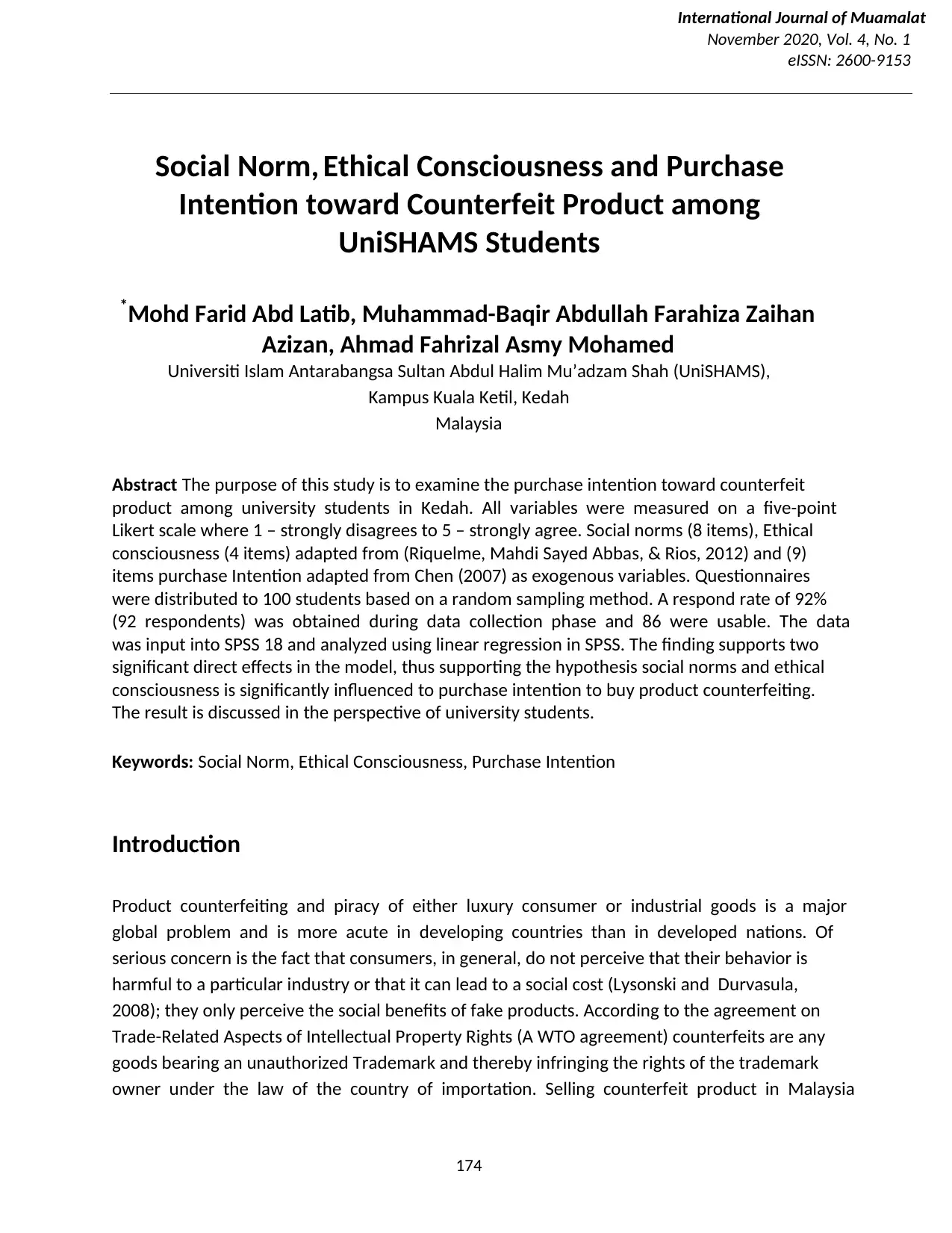
International Journal of Muamalat
November 2020, Vol. 4, No. 1
eISSN: 2600-9153
174
Social Norm, Ethical Consciousness and Purchase
Intention toward Counterfeit Product among
UniSHAMS Students
*Mohd Farid Abd Latib, Muhammad-Baqir Abdullah Farahiza Zaihan
Azizan, Ahmad Fahrizal Asmy Mohamed
Universiti Islam Antarabangsa Sultan Abdul Halim Mu’adzam Shah (UniSHAMS),
Kampus Kuala Ketil, Kedah
Malaysia
Abstract The purpose of this study is to examine the purchase intention toward counterfeit
product among university students in Kedah. All variables were measured on a five-point
Likert scale where 1 – strongly disagrees to 5 – strongly agree. Social norms (8 items), Ethical
consciousness (4 items) adapted from (Riquelme, Mahdi Sayed Abbas, & Rios, 2012) and (9)
items purchase Intention adapted from Chen (2007) as exogenous variables. Questionnaires
were distributed to 100 students based on a random sampling method. A respond rate of 92%
(92 respondents) was obtained during data collection phase and 86 were usable. The data
was input into SPSS 18 and analyzed using linear regression in SPSS. The finding supports two
significant direct effects in the model, thus supporting the hypothesis social norms and ethical
consciousness is significantly influenced to purchase intention to buy product counterfeiting.
The result is discussed in the perspective of university students.
Keywords: Social Norm, Ethical Consciousness, Purchase Intention
Introduction
Product counterfeiting and piracy of either luxury consumer or industrial goods is a major
global problem and is more acute in developing countries than in developed nations. Of
serious concern is the fact that consumers, in general, do not perceive that their behavior is
harmful to a particular industry or that it can lead to a social cost (Lysonski and Durvasula,
2008); they only perceive the social benefits of fake products. According to the agreement on
Trade-Related Aspects of Intellectual Property Rights (A WTO agreement) counterfeits are any
goods bearing an unauthorized Trademark and thereby infringing the rights of the trademark
owner under the law of the country of importation. Selling counterfeit product in Malaysia
November 2020, Vol. 4, No. 1
eISSN: 2600-9153
174
Social Norm, Ethical Consciousness and Purchase
Intention toward Counterfeit Product among
UniSHAMS Students
*Mohd Farid Abd Latib, Muhammad-Baqir Abdullah Farahiza Zaihan
Azizan, Ahmad Fahrizal Asmy Mohamed
Universiti Islam Antarabangsa Sultan Abdul Halim Mu’adzam Shah (UniSHAMS),
Kampus Kuala Ketil, Kedah
Malaysia
Abstract The purpose of this study is to examine the purchase intention toward counterfeit
product among university students in Kedah. All variables were measured on a five-point
Likert scale where 1 – strongly disagrees to 5 – strongly agree. Social norms (8 items), Ethical
consciousness (4 items) adapted from (Riquelme, Mahdi Sayed Abbas, & Rios, 2012) and (9)
items purchase Intention adapted from Chen (2007) as exogenous variables. Questionnaires
were distributed to 100 students based on a random sampling method. A respond rate of 92%
(92 respondents) was obtained during data collection phase and 86 were usable. The data
was input into SPSS 18 and analyzed using linear regression in SPSS. The finding supports two
significant direct effects in the model, thus supporting the hypothesis social norms and ethical
consciousness is significantly influenced to purchase intention to buy product counterfeiting.
The result is discussed in the perspective of university students.
Keywords: Social Norm, Ethical Consciousness, Purchase Intention
Introduction
Product counterfeiting and piracy of either luxury consumer or industrial goods is a major
global problem and is more acute in developing countries than in developed nations. Of
serious concern is the fact that consumers, in general, do not perceive that their behavior is
harmful to a particular industry or that it can lead to a social cost (Lysonski and Durvasula,
2008); they only perceive the social benefits of fake products. According to the agreement on
Trade-Related Aspects of Intellectual Property Rights (A WTO agreement) counterfeits are any
goods bearing an unauthorized Trademark and thereby infringing the rights of the trademark
owner under the law of the country of importation. Selling counterfeit product in Malaysia
Paraphrase This Document
Need a fresh take? Get an instant paraphrase of this document with our AI Paraphraser
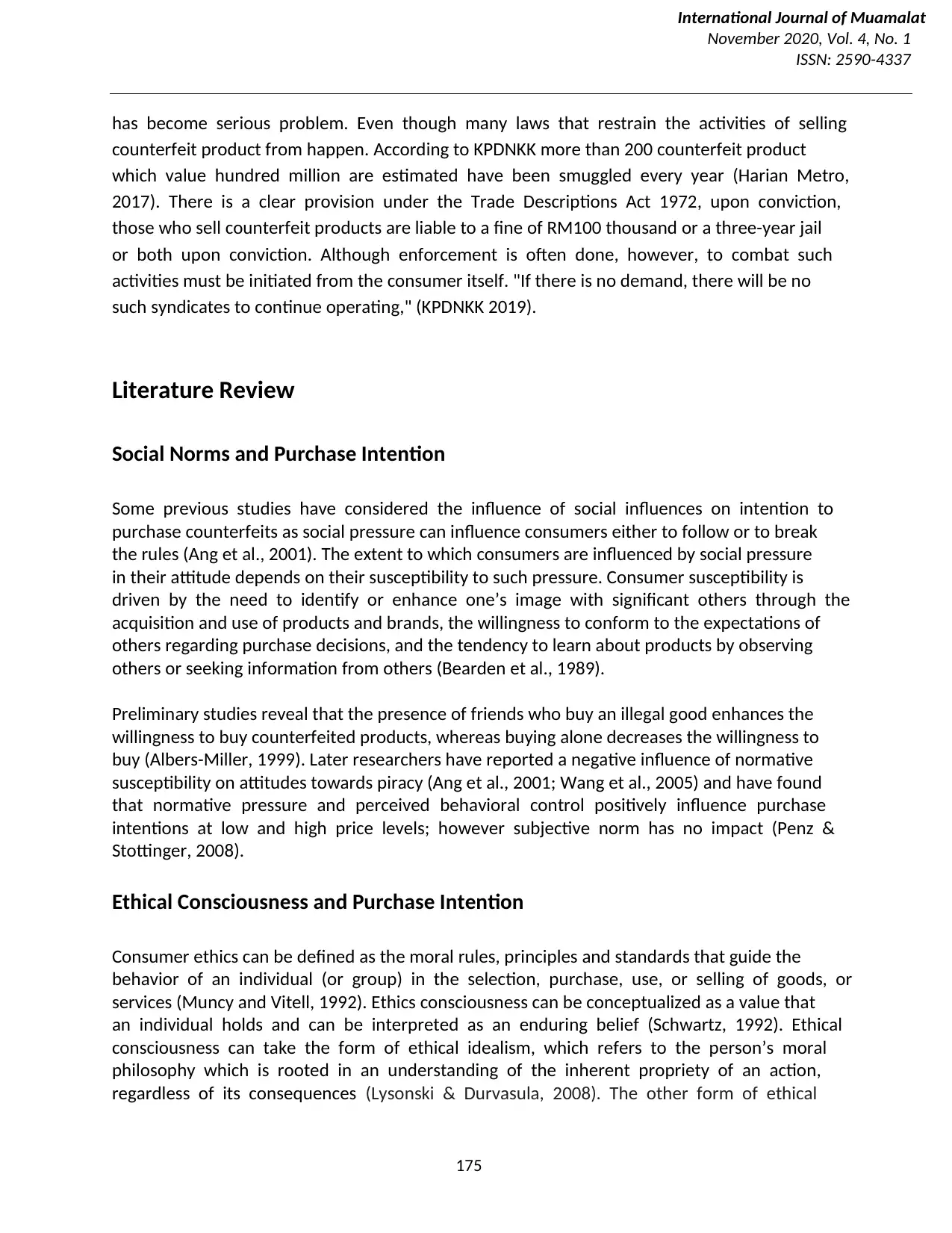
International Journal of Muamalat
November 2020, Vol. 4, No. 1
ISSN: 2590-4337
175
has become serious problem. Even though many laws that restrain the activities of selling
counterfeit product from happen. According to KPDNKK more than 200 counterfeit product
which value hundred million are estimated have been smuggled every year (Harian Metro,
2017). There is a clear provision under the Trade Descriptions Act 1972, upon conviction,
those who sell counterfeit products are liable to a fine of RM100 thousand or a three-year jail
or both upon conviction. Although enforcement is often done, however, to combat such
activities must be initiated from the consumer itself. "If there is no demand, there will be no
such syndicates to continue operating," (KPDNKK 2019).
Literature Review
Social Norms and Purchase Intention
Some previous studies have considered the influence of social influences on intention to
purchase counterfeits as social pressure can influence consumers either to follow or to break
the rules (Ang et al., 2001). The extent to which consumers are influenced by social pressure
in their attitude depends on their susceptibility to such pressure. Consumer susceptibility is
driven by the need to identify or enhance one’s image with significant others through the
acquisition and use of products and brands, the willingness to conform to the expectations of
others regarding purchase decisions, and the tendency to learn about products by observing
others or seeking information from others (Bearden et al., 1989).
Preliminary studies reveal that the presence of friends who buy an illegal good enhances the
willingness to buy counterfeited products, whereas buying alone decreases the willingness to
buy (Albers-Miller, 1999). Later researchers have reported a negative influence of normative
susceptibility on attitudes towards piracy (Ang et al., 2001; Wang et al., 2005) and have found
that normative pressure and perceived behavioral control positively influence purchase
intentions at low and high price levels; however subjective norm has no impact (Penz &
Stottinger, 2008).
Ethical Consciousness and Purchase Intention
Consumer ethics can be defined as the moral rules, principles and standards that guide the
behavior of an individual (or group) in the selection, purchase, use, or selling of goods, or
services (Muncy and Vitell, 1992). Ethics consciousness can be conceptualized as a value that
an individual holds and can be interpreted as an enduring belief (Schwartz, 1992). Ethical
consciousness can take the form of ethical idealism, which refers to the person’s moral
philosophy which is rooted in an understanding of the inherent propriety of an action,
regardless of its consequences (Lysonski & Durvasula, 2008). The other form of ethical
November 2020, Vol. 4, No. 1
ISSN: 2590-4337
175
has become serious problem. Even though many laws that restrain the activities of selling
counterfeit product from happen. According to KPDNKK more than 200 counterfeit product
which value hundred million are estimated have been smuggled every year (Harian Metro,
2017). There is a clear provision under the Trade Descriptions Act 1972, upon conviction,
those who sell counterfeit products are liable to a fine of RM100 thousand or a three-year jail
or both upon conviction. Although enforcement is often done, however, to combat such
activities must be initiated from the consumer itself. "If there is no demand, there will be no
such syndicates to continue operating," (KPDNKK 2019).
Literature Review
Social Norms and Purchase Intention
Some previous studies have considered the influence of social influences on intention to
purchase counterfeits as social pressure can influence consumers either to follow or to break
the rules (Ang et al., 2001). The extent to which consumers are influenced by social pressure
in their attitude depends on their susceptibility to such pressure. Consumer susceptibility is
driven by the need to identify or enhance one’s image with significant others through the
acquisition and use of products and brands, the willingness to conform to the expectations of
others regarding purchase decisions, and the tendency to learn about products by observing
others or seeking information from others (Bearden et al., 1989).
Preliminary studies reveal that the presence of friends who buy an illegal good enhances the
willingness to buy counterfeited products, whereas buying alone decreases the willingness to
buy (Albers-Miller, 1999). Later researchers have reported a negative influence of normative
susceptibility on attitudes towards piracy (Ang et al., 2001; Wang et al., 2005) and have found
that normative pressure and perceived behavioral control positively influence purchase
intentions at low and high price levels; however subjective norm has no impact (Penz &
Stottinger, 2008).
Ethical Consciousness and Purchase Intention
Consumer ethics can be defined as the moral rules, principles and standards that guide the
behavior of an individual (or group) in the selection, purchase, use, or selling of goods, or
services (Muncy and Vitell, 1992). Ethics consciousness can be conceptualized as a value that
an individual holds and can be interpreted as an enduring belief (Schwartz, 1992). Ethical
consciousness can take the form of ethical idealism, which refers to the person’s moral
philosophy which is rooted in an understanding of the inherent propriety of an action,
regardless of its consequences (Lysonski & Durvasula, 2008). The other form of ethical
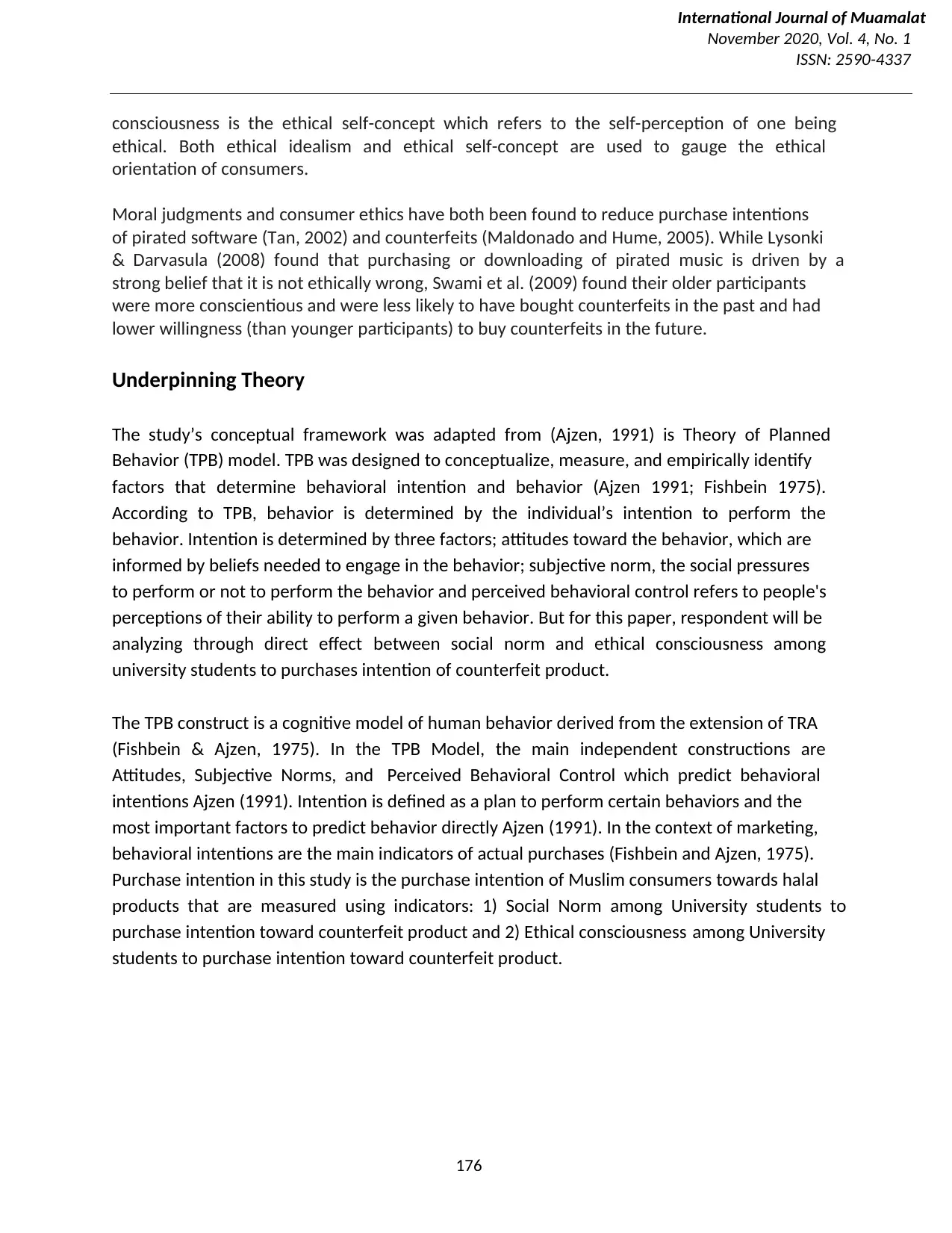
International Journal of Muamalat
November 2020, Vol. 4, No. 1
ISSN: 2590-4337
176
consciousness is the ethical self-concept which refers to the self-perception of one being
ethical. Both ethical idealism and ethical self-concept are used to gauge the ethical
orientation of consumers.
Moral judgments and consumer ethics have both been found to reduce purchase intentions
of pirated software (Tan, 2002) and counterfeits (Maldonado and Hume, 2005). While Lysonki
& Darvasula (2008) found that purchasing or downloading of pirated music is driven by a
strong belief that it is not ethically wrong, Swami et al. (2009) found their older participants
were more conscientious and were less likely to have bought counterfeits in the past and had
lower willingness (than younger participants) to buy counterfeits in the future.
Underpinning Theory
The study’s conceptual framework was adapted from (Ajzen, 1991) is Theory of Planned
Behavior (TPB) model. TPB was designed to conceptualize, measure, and empirically identify
factors that determine behavioral intention and behavior (Ajzen 1991; Fishbein 1975).
According to TPB, behavior is determined by the individual’s intention to perform the
behavior. Intention is determined by three factors; attitudes toward the behavior, which are
informed by beliefs needed to engage in the behavior; subjective norm, the social pressures
to perform or not to perform the behavior and perceived behavioral control refers to people's
perceptions of their ability to perform a given behavior. But for this paper, respondent will be
analyzing through direct effect between social norm and ethical consciousness among
university students to purchases intention of counterfeit product.
The TPB construct is a cognitive model of human behavior derived from the extension of TRA
(Fishbein & Ajzen, 1975). In the TPB Model, the main independent constructions are
Attitudes, Subjective Norms, and Perceived Behavioral Control which predict behavioral
intentions Ajzen (1991). Intention is defined as a plan to perform certain behaviors and the
most important factors to predict behavior directly Ajzen (1991). In the context of marketing,
behavioral intentions are the main indicators of actual purchases (Fishbein and Ajzen, 1975).
Purchase intention in this study is the purchase intention of Muslim consumers towards halal
products that are measured using indicators: 1) Social Norm among University students to
purchase intention toward counterfeit product and 2) Ethical consciousness among University
students to purchase intention toward counterfeit product.
November 2020, Vol. 4, No. 1
ISSN: 2590-4337
176
consciousness is the ethical self-concept which refers to the self-perception of one being
ethical. Both ethical idealism and ethical self-concept are used to gauge the ethical
orientation of consumers.
Moral judgments and consumer ethics have both been found to reduce purchase intentions
of pirated software (Tan, 2002) and counterfeits (Maldonado and Hume, 2005). While Lysonki
& Darvasula (2008) found that purchasing or downloading of pirated music is driven by a
strong belief that it is not ethically wrong, Swami et al. (2009) found their older participants
were more conscientious and were less likely to have bought counterfeits in the past and had
lower willingness (than younger participants) to buy counterfeits in the future.
Underpinning Theory
The study’s conceptual framework was adapted from (Ajzen, 1991) is Theory of Planned
Behavior (TPB) model. TPB was designed to conceptualize, measure, and empirically identify
factors that determine behavioral intention and behavior (Ajzen 1991; Fishbein 1975).
According to TPB, behavior is determined by the individual’s intention to perform the
behavior. Intention is determined by three factors; attitudes toward the behavior, which are
informed by beliefs needed to engage in the behavior; subjective norm, the social pressures
to perform or not to perform the behavior and perceived behavioral control refers to people's
perceptions of their ability to perform a given behavior. But for this paper, respondent will be
analyzing through direct effect between social norm and ethical consciousness among
university students to purchases intention of counterfeit product.
The TPB construct is a cognitive model of human behavior derived from the extension of TRA
(Fishbein & Ajzen, 1975). In the TPB Model, the main independent constructions are
Attitudes, Subjective Norms, and Perceived Behavioral Control which predict behavioral
intentions Ajzen (1991). Intention is defined as a plan to perform certain behaviors and the
most important factors to predict behavior directly Ajzen (1991). In the context of marketing,
behavioral intentions are the main indicators of actual purchases (Fishbein and Ajzen, 1975).
Purchase intention in this study is the purchase intention of Muslim consumers towards halal
products that are measured using indicators: 1) Social Norm among University students to
purchase intention toward counterfeit product and 2) Ethical consciousness among University
students to purchase intention toward counterfeit product.
⊘ This is a preview!⊘
Do you want full access?
Subscribe today to unlock all pages.

Trusted by 1+ million students worldwide
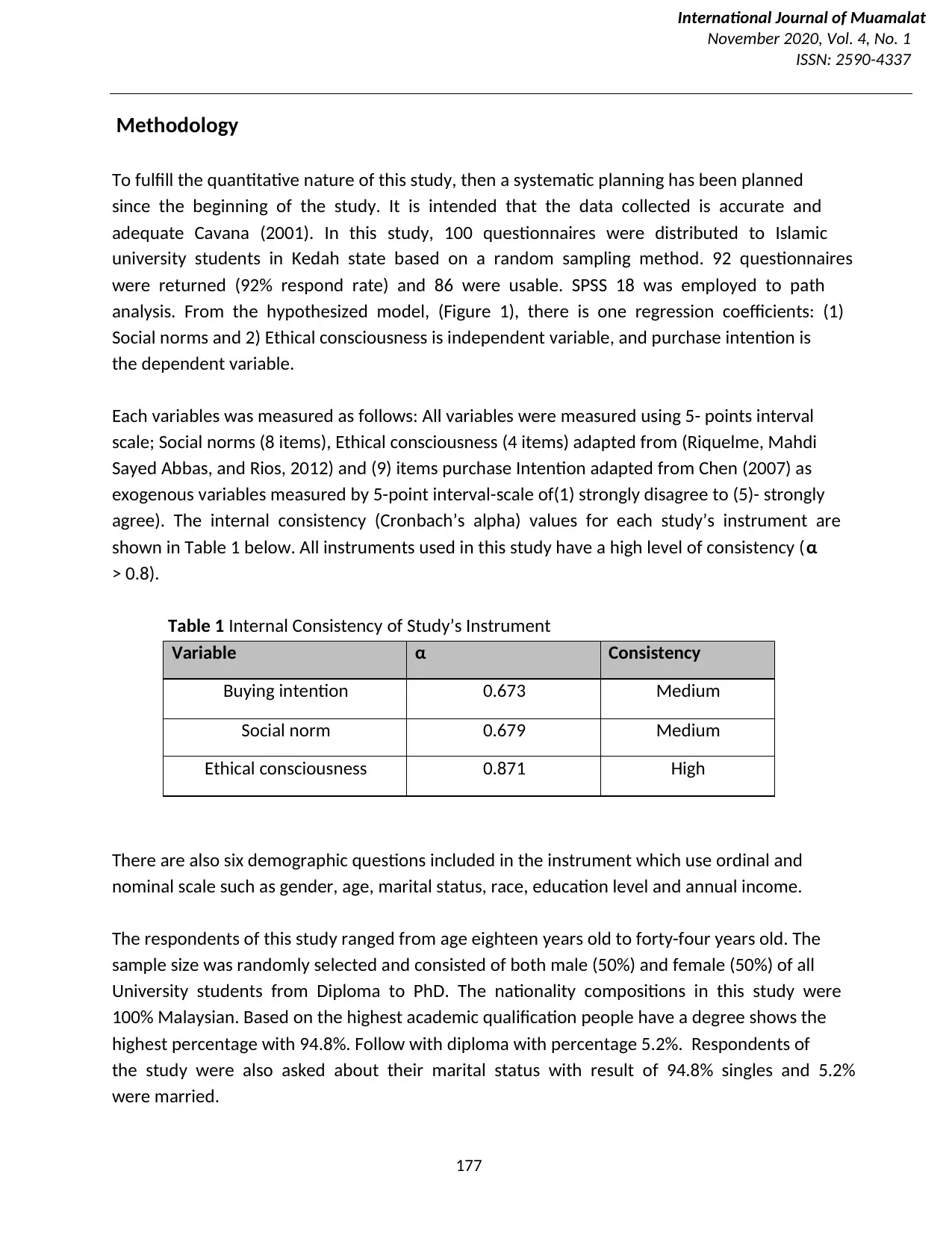
International Journal of Muamalat
November 2020, Vol. 4, No. 1
ISSN: 2590-4337
177
Methodology
To fulfill the quantitative nature of this study, then a systematic planning has been planned
since the beginning of the study. It is intended that the data collected is accurate and
adequate Cavana (2001). In this study, 100 questionnaires were distributed to Islamic
university students in Kedah state based on a random sampling method. 92 questionnaires
were returned (92% respond rate) and 86 were usable. SPSS 18 was employed to path
analysis. From the hypothesized model, (Figure 1), there is one regression coefficients: (1)
Social norms and 2) Ethical consciousness is independent variable, and purchase intention is
the dependent variable.
Each variables was measured as follows: All variables were measured using 5- points interval
scale; Social norms (8 items), Ethical consciousness (4 items) adapted from (Riquelme, Mahdi
Sayed Abbas, and Rios, 2012) and (9) items purchase Intention adapted from Chen (2007) as
exogenous variables measured by 5-point interval-scale of(1) strongly disagree to (5)- strongly
agree). The internal consistency (Cronbach’s alpha) values for each study’s instrument are
shown in Table 1 below. All instruments used in this study have a high level of consistency (α
> 0.8).
Table 1 Internal Consistency of Study’s Instrument
Variable α Consistency
Buying intention 0.673 Medium
Social norm 0.679 Medium
Ethical consciousness 0.871 High
There are also six demographic questions included in the instrument which use ordinal and
nominal scale such as gender, age, marital status, race, education level and annual income.
The respondents of this study ranged from age eighteen years old to forty-four years old. The
sample size was randomly selected and consisted of both male (50%) and female (50%) of all
University students from Diploma to PhD. The nationality compositions in this study were
100% Malaysian. Based on the highest academic qualification people have a degree shows the
highest percentage with 94.8%. Follow with diploma with percentage 5.2%. Respondents of
the study were also asked about their marital status with result of 94.8% singles and 5.2%
were married.
November 2020, Vol. 4, No. 1
ISSN: 2590-4337
177
Methodology
To fulfill the quantitative nature of this study, then a systematic planning has been planned
since the beginning of the study. It is intended that the data collected is accurate and
adequate Cavana (2001). In this study, 100 questionnaires were distributed to Islamic
university students in Kedah state based on a random sampling method. 92 questionnaires
were returned (92% respond rate) and 86 were usable. SPSS 18 was employed to path
analysis. From the hypothesized model, (Figure 1), there is one regression coefficients: (1)
Social norms and 2) Ethical consciousness is independent variable, and purchase intention is
the dependent variable.
Each variables was measured as follows: All variables were measured using 5- points interval
scale; Social norms (8 items), Ethical consciousness (4 items) adapted from (Riquelme, Mahdi
Sayed Abbas, and Rios, 2012) and (9) items purchase Intention adapted from Chen (2007) as
exogenous variables measured by 5-point interval-scale of(1) strongly disagree to (5)- strongly
agree). The internal consistency (Cronbach’s alpha) values for each study’s instrument are
shown in Table 1 below. All instruments used in this study have a high level of consistency (α
> 0.8).
Table 1 Internal Consistency of Study’s Instrument
Variable α Consistency
Buying intention 0.673 Medium
Social norm 0.679 Medium
Ethical consciousness 0.871 High
There are also six demographic questions included in the instrument which use ordinal and
nominal scale such as gender, age, marital status, race, education level and annual income.
The respondents of this study ranged from age eighteen years old to forty-four years old. The
sample size was randomly selected and consisted of both male (50%) and female (50%) of all
University students from Diploma to PhD. The nationality compositions in this study were
100% Malaysian. Based on the highest academic qualification people have a degree shows the
highest percentage with 94.8%. Follow with diploma with percentage 5.2%. Respondents of
the study were also asked about their marital status with result of 94.8% singles and 5.2%
were married.
Paraphrase This Document
Need a fresh take? Get an instant paraphrase of this document with our AI Paraphraser
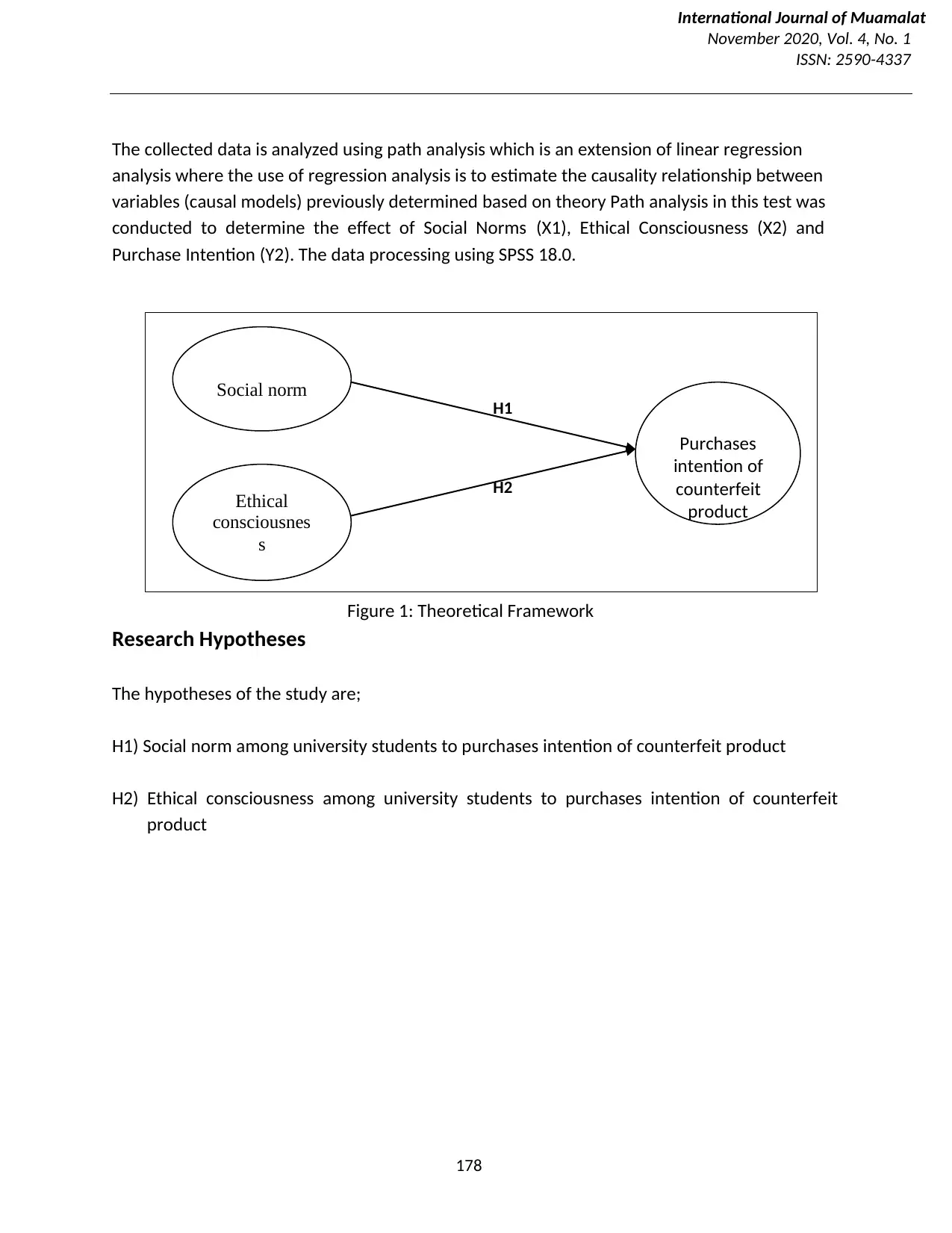
International Journal of Muamalat
November 2020, Vol. 4, No. 1
ISSN: 2590-4337
178
The collected data is analyzed using path analysis which is an extension of linear regression
analysis where the use of regression analysis is to estimate the causality relationship between
variables (causal models) previously determined based on theory Path analysis in this test was
conducted to determine the effect of Social Norms (X1), Ethical Consciousness (X2) and
Purchase Intention (Y2). The data processing using SPSS 18.0.
Figure 1 Research Framework
Figure 1: Theoretical Framework
Research Hypotheses
The hypotheses of the study are;
H1) Social norm among university students to purchases intention of counterfeit product
H2) Ethical consciousness among university students to purchases intention of counterfeit
product
H1
H2
Social norm
Ethical
consciousnes
s
Purchases
intention of
counterfeit
product
November 2020, Vol. 4, No. 1
ISSN: 2590-4337
178
The collected data is analyzed using path analysis which is an extension of linear regression
analysis where the use of regression analysis is to estimate the causality relationship between
variables (causal models) previously determined based on theory Path analysis in this test was
conducted to determine the effect of Social Norms (X1), Ethical Consciousness (X2) and
Purchase Intention (Y2). The data processing using SPSS 18.0.
Figure 1 Research Framework
Figure 1: Theoretical Framework
Research Hypotheses
The hypotheses of the study are;
H1) Social norm among university students to purchases intention of counterfeit product
H2) Ethical consciousness among university students to purchases intention of counterfeit
product
H1
H2
Social norm
Ethical
consciousnes
s
Purchases
intention of
counterfeit
product
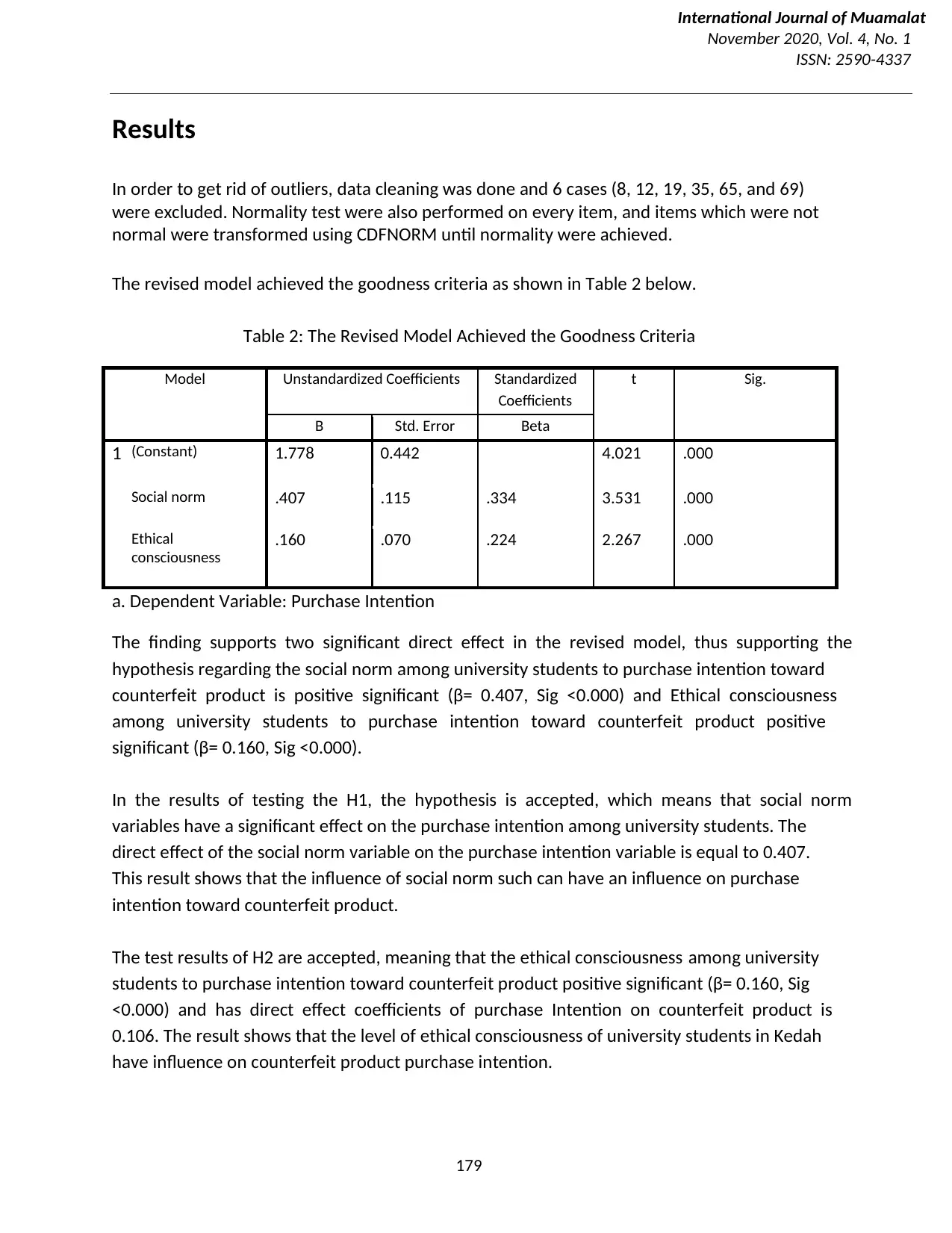
International Journal of Muamalat
November 2020, Vol. 4, No. 1
ISSN: 2590-4337
179
Results
In order to get rid of outliers, data cleaning was done and 6 cases (8, 12, 19, 35, 65, and 69)
were excluded. Normality test were also performed on every item, and items which were not
normal were transformed using CDFNORM until normality were achieved.
The revised model achieved the goodness criteria as shown in Table 2 below.
Table 2: The Revised Model Achieved the Goodness Criteria
Model Unstandardized Coefficients Standardized
Coefficients
t Sig.
B Std. Error Beta
1 (Constant) 1.778 0.442 4.021 .000
Social norm .407 .115 .334 3.531 .000
Ethical
consciousness
.160 .070 .224 2.267 .000
a. Dependent Variable: Purchase Intention
The finding supports two significant direct effect in the revised model, thus supporting the
hypothesis regarding the social norm among university students to purchase intention toward
counterfeit product is positive significant (β= 0.407, Sig <0.000) and Ethical consciousness
among university students to purchase intention toward counterfeit product positive
significant (β= 0.160, Sig <0.000).
In the results of testing the H1, the hypothesis is accepted, which means that social norm
variables have a significant effect on the purchase intention among university students. The
direct effect of the social norm variable on the purchase intention variable is equal to 0.407.
This result shows that the influence of social norm such can have an influence on purchase
intention toward counterfeit product.
The test results of H2 are accepted, meaning that the ethical consciousness among university
students to purchase intention toward counterfeit product positive significant (β= 0.160, Sig
<0.000) and has direct effect coefficients of purchase Intention on counterfeit product is
0.106. The result shows that the level of ethical consciousness of university students in Kedah
have influence on counterfeit product purchase intention.
November 2020, Vol. 4, No. 1
ISSN: 2590-4337
179
Results
In order to get rid of outliers, data cleaning was done and 6 cases (8, 12, 19, 35, 65, and 69)
were excluded. Normality test were also performed on every item, and items which were not
normal were transformed using CDFNORM until normality were achieved.
The revised model achieved the goodness criteria as shown in Table 2 below.
Table 2: The Revised Model Achieved the Goodness Criteria
Model Unstandardized Coefficients Standardized
Coefficients
t Sig.
B Std. Error Beta
1 (Constant) 1.778 0.442 4.021 .000
Social norm .407 .115 .334 3.531 .000
Ethical
consciousness
.160 .070 .224 2.267 .000
a. Dependent Variable: Purchase Intention
The finding supports two significant direct effect in the revised model, thus supporting the
hypothesis regarding the social norm among university students to purchase intention toward
counterfeit product is positive significant (β= 0.407, Sig <0.000) and Ethical consciousness
among university students to purchase intention toward counterfeit product positive
significant (β= 0.160, Sig <0.000).
In the results of testing the H1, the hypothesis is accepted, which means that social norm
variables have a significant effect on the purchase intention among university students. The
direct effect of the social norm variable on the purchase intention variable is equal to 0.407.
This result shows that the influence of social norm such can have an influence on purchase
intention toward counterfeit product.
The test results of H2 are accepted, meaning that the ethical consciousness among university
students to purchase intention toward counterfeit product positive significant (β= 0.160, Sig
<0.000) and has direct effect coefficients of purchase Intention on counterfeit product is
0.106. The result shows that the level of ethical consciousness of university students in Kedah
have influence on counterfeit product purchase intention.
⊘ This is a preview!⊘
Do you want full access?
Subscribe today to unlock all pages.

Trusted by 1+ million students worldwide
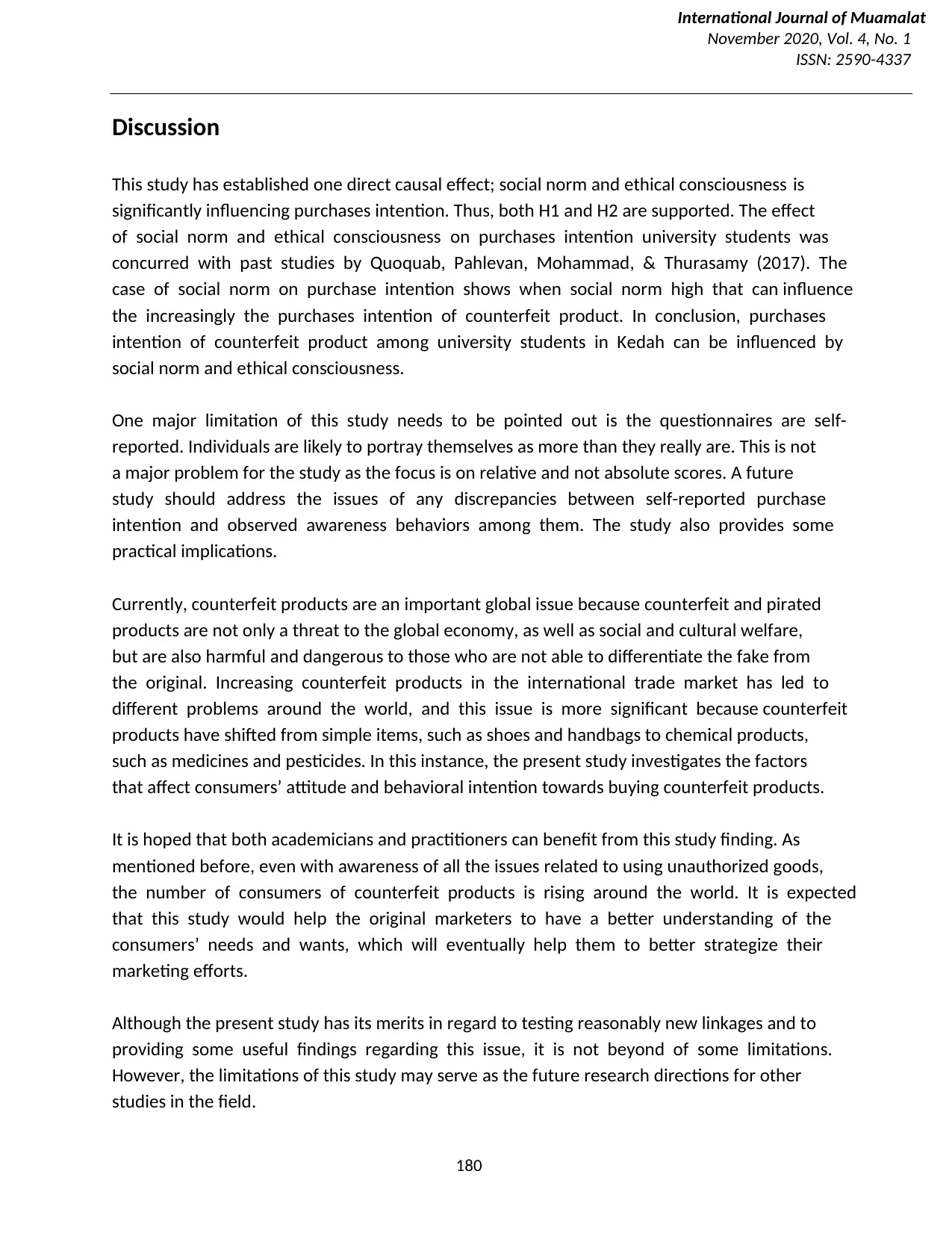
International Journal of Muamalat
November 2020, Vol. 4, No. 1
ISSN: 2590-4337
180
Discussion
This study has established one direct causal effect; social norm and ethical consciousness is
significantly influencing purchases intention. Thus, both H1 and H2 are supported. The effect
of social norm and ethical consciousness on purchases intention university students was
concurred with past studies by Quoquab, Pahlevan, Mohammad, & Thurasamy (2017). The
case of social norm on purchase intention shows when social norm high that can influence
the increasingly the purchases intention of counterfeit product. In conclusion, purchases
intention of counterfeit product among university students in Kedah can be influenced by
social norm and ethical consciousness.
One major limitation of this study needs to be pointed out is the questionnaires are self-
reported. Individuals are likely to portray themselves as more than they really are. This is not
a major problem for the study as the focus is on relative and not absolute scores. A future
study should address the issues of any discrepancies between self-reported purchase
intention and observed awareness behaviors among them. The study also provides some
practical implications.
Currently, counterfeit products are an important global issue because counterfeit and pirated
products are not only a threat to the global economy, as well as social and cultural welfare,
but are also harmful and dangerous to those who are not able to differentiate the fake from
the original. Increasing counterfeit products in the international trade market has led to
different problems around the world, and this issue is more significant because counterfeit
products have shifted from simple items, such as shoes and handbags to chemical products,
such as medicines and pesticides. In this instance, the present study investigates the factors
that affect consumers’ attitude and behavioral intention towards buying counterfeit products.
It is hoped that both academicians and practitioners can benefit from this study finding. As
mentioned before, even with awareness of all the issues related to using unauthorized goods,
the number of consumers of counterfeit products is rising around the world. It is expected
that this study would help the original marketers to have a better understanding of the
consumers’ needs and wants, which will eventually help them to better strategize their
marketing efforts.
Although the present study has its merits in regard to testing reasonably new linkages and to
providing some useful findings regarding this issue, it is not beyond of some limitations.
However, the limitations of this study may serve as the future research directions for other
studies in the field.
November 2020, Vol. 4, No. 1
ISSN: 2590-4337
180
Discussion
This study has established one direct causal effect; social norm and ethical consciousness is
significantly influencing purchases intention. Thus, both H1 and H2 are supported. The effect
of social norm and ethical consciousness on purchases intention university students was
concurred with past studies by Quoquab, Pahlevan, Mohammad, & Thurasamy (2017). The
case of social norm on purchase intention shows when social norm high that can influence
the increasingly the purchases intention of counterfeit product. In conclusion, purchases
intention of counterfeit product among university students in Kedah can be influenced by
social norm and ethical consciousness.
One major limitation of this study needs to be pointed out is the questionnaires are self-
reported. Individuals are likely to portray themselves as more than they really are. This is not
a major problem for the study as the focus is on relative and not absolute scores. A future
study should address the issues of any discrepancies between self-reported purchase
intention and observed awareness behaviors among them. The study also provides some
practical implications.
Currently, counterfeit products are an important global issue because counterfeit and pirated
products are not only a threat to the global economy, as well as social and cultural welfare,
but are also harmful and dangerous to those who are not able to differentiate the fake from
the original. Increasing counterfeit products in the international trade market has led to
different problems around the world, and this issue is more significant because counterfeit
products have shifted from simple items, such as shoes and handbags to chemical products,
such as medicines and pesticides. In this instance, the present study investigates the factors
that affect consumers’ attitude and behavioral intention towards buying counterfeit products.
It is hoped that both academicians and practitioners can benefit from this study finding. As
mentioned before, even with awareness of all the issues related to using unauthorized goods,
the number of consumers of counterfeit products is rising around the world. It is expected
that this study would help the original marketers to have a better understanding of the
consumers’ needs and wants, which will eventually help them to better strategize their
marketing efforts.
Although the present study has its merits in regard to testing reasonably new linkages and to
providing some useful findings regarding this issue, it is not beyond of some limitations.
However, the limitations of this study may serve as the future research directions for other
studies in the field.
Paraphrase This Document
Need a fresh take? Get an instant paraphrase of this document with our AI Paraphraser
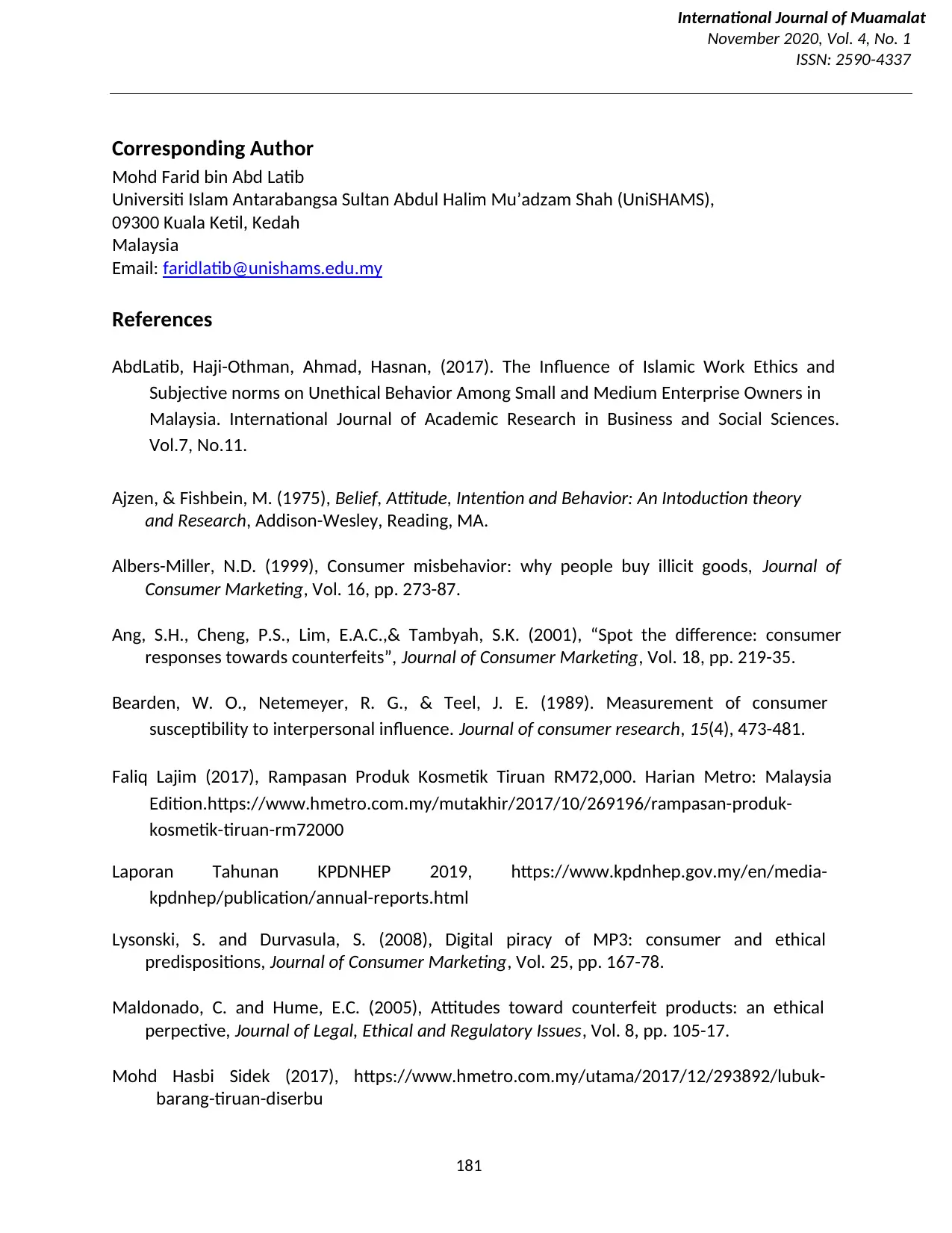
International Journal of Muamalat
November 2020, Vol. 4, No. 1
ISSN: 2590-4337
181
Corresponding Author
Mohd Farid bin Abd Latib
Universiti Islam Antarabangsa Sultan Abdul Halim Mu’adzam Shah (UniSHAMS),
09300 Kuala Ketil, Kedah
Malaysia
Email: faridlatib@unishams.edu.my
References
AbdLatib, Haji-Othman, Ahmad, Hasnan, (2017). The Influence of Islamic Work Ethics and
Subjective norms on Unethical Behavior Among Small and Medium Enterprise Owners in
Malaysia. International Journal of Academic Research in Business and Social Sciences.
Vol.7, No.11.
Ajzen, & Fishbein, M. (1975), Belief, Attitude, Intention and Behavior: An Intoduction theory
and Research, Addison-Wesley, Reading, MA.
Albers-Miller, N.D. (1999), Consumer misbehavior: why people buy illicit goods, Journal of
Consumer Marketing, Vol. 16, pp. 273-87.
Ang, S.H., Cheng, P.S., Lim, E.A.C.,& Tambyah, S.K. (2001), “Spot the difference: consumer
responses towards counterfeits”, Journal of Consumer Marketing, Vol. 18, pp. 219-35.
Bearden, W. O., Netemeyer, R. G., & Teel, J. E. (1989). Measurement of consumer
susceptibility to interpersonal influence. Journal of consumer research, 15(4), 473-481.
Faliq Lajim (2017), Rampasan Produk Kosmetik Tiruan RM72,000. Harian Metro: Malaysia
Edition.https://www.hmetro.com.my/mutakhir/2017/10/269196/rampasan-produk-
kosmetik-tiruan-rm72000
Laporan Tahunan KPDNHEP 2019, https://www.kpdnhep.gov.my/en/media-
kpdnhep/publication/annual-reports.html
Lysonski, S. and Durvasula, S. (2008), Digital piracy of MP3: consumer and ethical
predispositions, Journal of Consumer Marketing, Vol. 25, pp. 167-78.
Maldonado, C. and Hume, E.C. (2005), Attitudes toward counterfeit products: an ethical
perpective, Journal of Legal, Ethical and Regulatory Issues, Vol. 8, pp. 105-17.
Mohd Hasbi Sidek (2017), https://www.hmetro.com.my/utama/2017/12/293892/lubuk-
barang-tiruan-diserbu
November 2020, Vol. 4, No. 1
ISSN: 2590-4337
181
Corresponding Author
Mohd Farid bin Abd Latib
Universiti Islam Antarabangsa Sultan Abdul Halim Mu’adzam Shah (UniSHAMS),
09300 Kuala Ketil, Kedah
Malaysia
Email: faridlatib@unishams.edu.my
References
AbdLatib, Haji-Othman, Ahmad, Hasnan, (2017). The Influence of Islamic Work Ethics and
Subjective norms on Unethical Behavior Among Small and Medium Enterprise Owners in
Malaysia. International Journal of Academic Research in Business and Social Sciences.
Vol.7, No.11.
Ajzen, & Fishbein, M. (1975), Belief, Attitude, Intention and Behavior: An Intoduction theory
and Research, Addison-Wesley, Reading, MA.
Albers-Miller, N.D. (1999), Consumer misbehavior: why people buy illicit goods, Journal of
Consumer Marketing, Vol. 16, pp. 273-87.
Ang, S.H., Cheng, P.S., Lim, E.A.C.,& Tambyah, S.K. (2001), “Spot the difference: consumer
responses towards counterfeits”, Journal of Consumer Marketing, Vol. 18, pp. 219-35.
Bearden, W. O., Netemeyer, R. G., & Teel, J. E. (1989). Measurement of consumer
susceptibility to interpersonal influence. Journal of consumer research, 15(4), 473-481.
Faliq Lajim (2017), Rampasan Produk Kosmetik Tiruan RM72,000. Harian Metro: Malaysia
Edition.https://www.hmetro.com.my/mutakhir/2017/10/269196/rampasan-produk-
kosmetik-tiruan-rm72000
Laporan Tahunan KPDNHEP 2019, https://www.kpdnhep.gov.my/en/media-
kpdnhep/publication/annual-reports.html
Lysonski, S. and Durvasula, S. (2008), Digital piracy of MP3: consumer and ethical
predispositions, Journal of Consumer Marketing, Vol. 25, pp. 167-78.
Maldonado, C. and Hume, E.C. (2005), Attitudes toward counterfeit products: an ethical
perpective, Journal of Legal, Ethical and Regulatory Issues, Vol. 8, pp. 105-17.
Mohd Hasbi Sidek (2017), https://www.hmetro.com.my/utama/2017/12/293892/lubuk-
barang-tiruan-diserbu
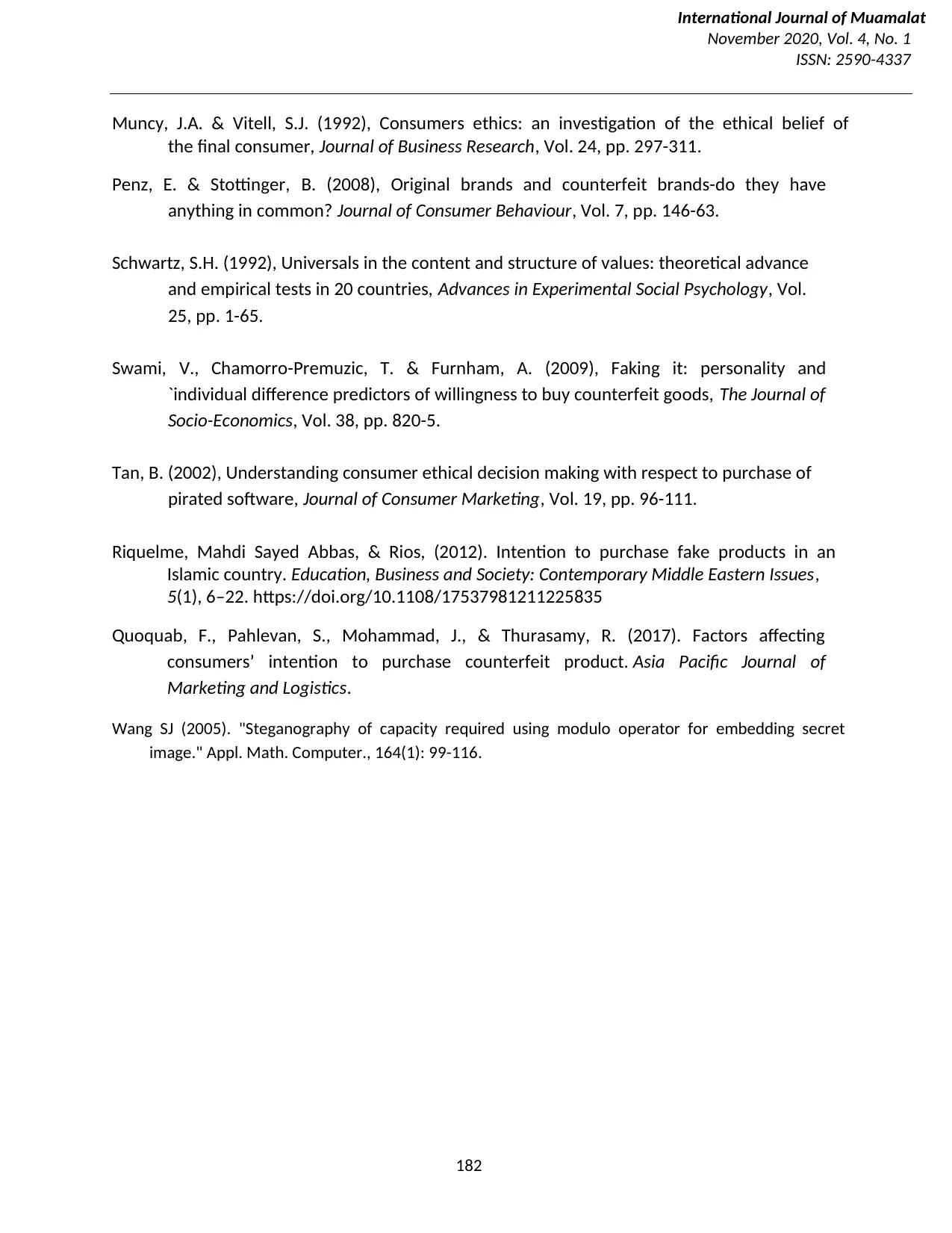
International Journal of Muamalat
November 2020, Vol. 4, No. 1
ISSN: 2590-4337
182
Muncy, J.A. & Vitell, S.J. (1992), Consumers ethics: an investigation of the ethical belief of
the final consumer, Journal of Business Research, Vol. 24, pp. 297-311.
Penz, E. & Stottinger, B. (2008), Original brands and counterfeit brands-do they have
anything in common? Journal of Consumer Behaviour, Vol. 7, pp. 146-63.
Schwartz, S.H. (1992), Universals in the content and structure of values: theoretical advance
and empirical tests in 20 countries, Advances in Experimental Social Psychology, Vol.
25, pp. 1-65.
Swami, V., Chamorro-Premuzic, T. & Furnham, A. (2009), Faking it: personality and
`individual difference predictors of willingness to buy counterfeit goods, The Journal of
Socio-Economics, Vol. 38, pp. 820-5.
Tan, B. (2002), Understanding consumer ethical decision making with respect to purchase of
pirated software, Journal of Consumer Marketing, Vol. 19, pp. 96-111.
Riquelme, Mahdi Sayed Abbas, & Rios, (2012). Intention to purchase fake products in an
Islamic country. Education, Business and Society: Contemporary Middle Eastern Issues,
5(1), 6–22. https://doi.org/10.1108/17537981211225835
Quoquab, F., Pahlevan, S., Mohammad, J., & Thurasamy, R. (2017). Factors affecting
consumers’ intention to purchase counterfeit product. Asia Pacific Journal of
Marketing and Logistics.
Wang SJ (2005). "Steganography of capacity required using modulo operator for embedding secret
image." Appl. Math. Computer., 164(1): 99-116.
November 2020, Vol. 4, No. 1
ISSN: 2590-4337
182
Muncy, J.A. & Vitell, S.J. (1992), Consumers ethics: an investigation of the ethical belief of
the final consumer, Journal of Business Research, Vol. 24, pp. 297-311.
Penz, E. & Stottinger, B. (2008), Original brands and counterfeit brands-do they have
anything in common? Journal of Consumer Behaviour, Vol. 7, pp. 146-63.
Schwartz, S.H. (1992), Universals in the content and structure of values: theoretical advance
and empirical tests in 20 countries, Advances in Experimental Social Psychology, Vol.
25, pp. 1-65.
Swami, V., Chamorro-Premuzic, T. & Furnham, A. (2009), Faking it: personality and
`individual difference predictors of willingness to buy counterfeit goods, The Journal of
Socio-Economics, Vol. 38, pp. 820-5.
Tan, B. (2002), Understanding consumer ethical decision making with respect to purchase of
pirated software, Journal of Consumer Marketing, Vol. 19, pp. 96-111.
Riquelme, Mahdi Sayed Abbas, & Rios, (2012). Intention to purchase fake products in an
Islamic country. Education, Business and Society: Contemporary Middle Eastern Issues,
5(1), 6–22. https://doi.org/10.1108/17537981211225835
Quoquab, F., Pahlevan, S., Mohammad, J., & Thurasamy, R. (2017). Factors affecting
consumers’ intention to purchase counterfeit product. Asia Pacific Journal of
Marketing and Logistics.
Wang SJ (2005). "Steganography of capacity required using modulo operator for embedding secret
image." Appl. Math. Computer., 164(1): 99-116.
⊘ This is a preview!⊘
Do you want full access?
Subscribe today to unlock all pages.

Trusted by 1+ million students worldwide
1 out of 9
Your All-in-One AI-Powered Toolkit for Academic Success.
+13062052269
info@desklib.com
Available 24*7 on WhatsApp / Email
![[object Object]](/_next/static/media/star-bottom.7253800d.svg)
Unlock your academic potential
Copyright © 2020–2025 A2Z Services. All Rights Reserved. Developed and managed by ZUCOL.